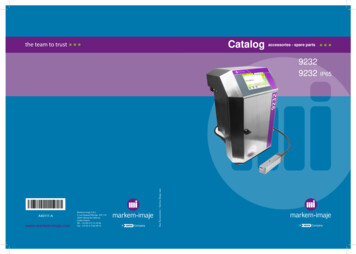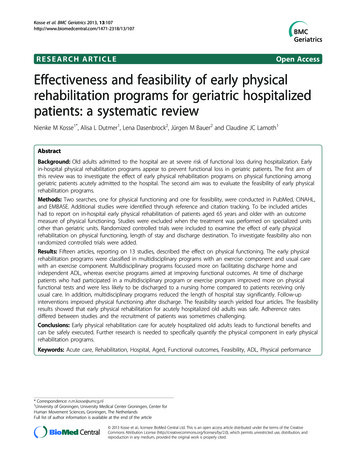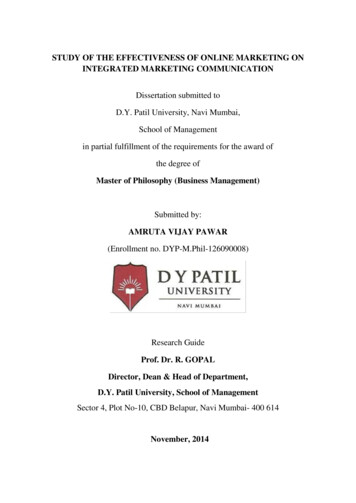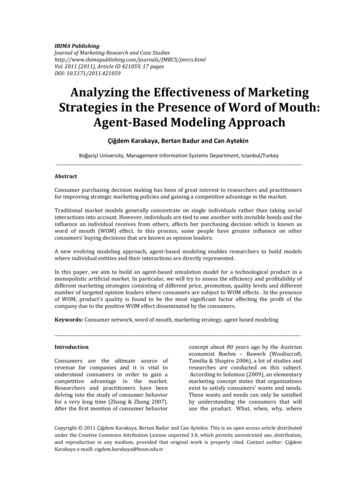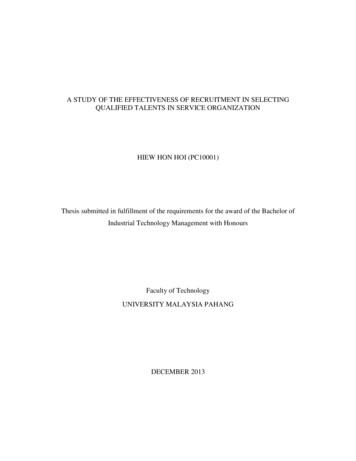
Transcription
Team Effectiveness and Six Essential Servant LeadershipThemes: A Regression Model Based on items in theOrganizational Leadership AssessmentJustin A. IrvingBethel UniversityGail J. LongbothamRegent UniversityAs evidenced by LaFasto and Larson’s (2001) work with over 6,000 team members and leaders, interestin teams continues to capture the attention of both leadership scholars and practitioners. Subsequently,research into what leadership behaviors contribute to team effectiveness becomes relevant for those at thecrossroads of theory and practice. Utilizing the Organizational Leadership Assessment (Laub, 1999) as ameasure of servant leadership and the Team Effectiveness Questionnaire (Larson & LaFasto, 2001) as ameasure of team effectiveness, this paper presents a multiple regression model that is able to explain asignificant percentage of the variance in the effectiveness of teams. The essential servant leadershipvariables identified were (a) providing accountability, (b) supporting and resourcing, (c) engaging inhonest self-evaluation, (d) fostering collaboration, (e) communicating with clarity, and (f) valuing andappreciating.Interest in the theory and practice of teams has grown dramatically in recent years as evidencedby LaFasto and Larson’s (2001) research with over 6,000 team members and leaders. Thisemergence of teams may be traced, in part, back to societal shifts which occurred in the 1960sand 1970s. One student of the impact of these shifts on organizational life was Robert K.Greenleaf. Writing in the 1970s, Greenleaf (1977) noted that in light of the revolution ofexpectation among young people, one who presides over a successful business “will need toevolve from being the chief into the builder of the team” (p. 85). It is arguable that such societaland organizational observations are even more relevant today as leaders seek to answer thequestion of how to lead organizations in the increasingly decentralized and team-based structuresthat are a growing mark of systems in the 21st century.International Journal of Leadership Studies, Vol. 2 Iss. 2, 2007, pp. 98-113 2007 School of Global Leadership & Entrepreneurship, Regent UniversityISSN 1554-3145
INTERNATIONAL JOURNAL OF LEADERSHIP STUDIES99Some have argued that these shifts toward team-based structures are consistent with theshifts from Newtonian to Quantum paradigms (Irving, 2005; Wheatley, 1999). Addressing thispoint, Margaret Wheatley argued that “relationship is the key determiner of everything” (p. 11),rooted in physical realities at the subatomic level. For instance, Wheatley noted that “subatomicparticles come into form and are observed only as they are in relationship to something else.They do not exist as independent ‘things’” (p. 11). From this, Wheatley argued that relationships,and not lone individuals, are the basic organizing unit of life. Therefore, participation andcooperation are essential for survival in this world of interconnected and networkedorganizations. These shifts toward the quantum world of thinking and organizing not only placean emphasis on relationships as the basic organizing unit; but they also emphasize (a) the wholeover the part, (b) dynamic processes over static processes, (c) organizational networks overorganizational hierarchies, and (d) systemic interconnectedness over linear progression andthought. The holistic focus on interconnectedness, relationship, and dynamic process innetworked organizations naturally lends itself to the use of relational organizational structuressuch as teams.Organizations reflect these macro shifts in our societies and lead to a critical leadershipquestion for those at the crossroads of leadership research and practice: what form of leadershipwill be most effective in our emerging world of team-based and networked systems? Thisquestion provided the impetus for this study, which was designed primarily to examine the effectof servant leadership on team effectiveness by examining which items in Laub’s (1999)Organizational Leadership Assessment (OLA) will have the most significant impact on teameffectiveness. The OLA as a single measure of servant leadership was the single greatestpredictor of team effectiveness in a previous analysis (Irving & Longbotham, 2006). In light ofthis, the authors concluded that a closer examination of the OLA was in order. Based on thisexamination, the authors present a multiple regression model that explores this effect andidentify six essential servant leadership themes that are especially predictive of teameffectiveness. Toward this end, the authors review the essential literature surrounding servantleadership and teams, present an overview of the methods and results, and discuss at length thefindings and implications of this study.Literature ReviewServant LeadershipThrough his initial work on servant leadership, Greenleaf (1977) provided a foundationfor the contemporary study and emerging discipline of servant leadership. The key to Greenleaf’sconceptualization of servant leadership is his understanding of what characterizes the servantleader, namely being a servant first. In response to the question, “Who is the servant-leader?”Greenleaf provided his now frequently quoted response:The servant-leader is servant first. . . . It begins with the natural feeling that one wants toserve, to serve first. Then conscious choice brings one to aspire to lead. That person issharply different from one who is leader first. . . . The difference manifests itself in thecare taken by the servant-first to make sure that other people’s highest priority needs arebeing served. The best test, and difficult to administer, is this: Do those served grow aspersons? Do they, while being served, become healthier, wiser, freer, more autonomous,more likely themselves to become servants? And, what is the effect on the least privilegedInternational Journal of Leadership Studies, Vol. 2 Iss. 2, 2007, pp. 98-113 2007 School of Global Leadership & Entrepreneurship, Regent UniversityISSN 1554-3145
Irving & Longbotham/INTERNATIONAL JOURNAL OF LEADERSHIP STUDIES100in society; will they benefit, or, at least, not be further deprived? (p. 27)While persons in the leader-first model may utilize service at times for the purpose ofrealizing the visions and goals of the leader and/or the organization; the servant-first model isfocused on making “sure that other people’s highest priority needs are being served” (p. 27) and,as such, is a follower-oriented theory of leadership (Laub, 1999; Matteson & Irving, 2005, 2006;Stone, Russell, & Patterson, 2004).Building on this servant-first notion of leadership; Laub (1999), Stone et al. (2004), andMatteson and Irving (2005, 2006) all argued that the focus of the servant leader is on that whichis best for their followers. On this point, Laub (2005) wrote, “servant leadership is anunderstanding and practice of leadership that places the good of those led over the self-interest ofthe leader” (p. 160). Stone et al. identified this point as a key to understanding what differentiatesservant leadership from transformational leadership. They argued that while transformationalleadership tends to be focused on an organizational vision (what is best for the organization),servant leadership is focused foremost on that which is best for the followers. Matteson andIrving (2005) took this a step further by contrasting the focus, motivation, context, and outcomesof transformational, servant, and self-sacrificial approaches to leadership.From the early 1990s through 2003, the work surrounding servant leadership focused onidentifying themes to help to operationalize the concept of servant leadership. Graham (1991)stressed the inspirational and moral dimensions. Buchen (1998) argued that self-identity,capacity for reciprocity, relationship building, and preoccupation with the future were essentialthemes. Spears (1998) emphasized the dimensions of listening, empathy, healing, awareness,persuasion, conceptualization, foresight, stewardship, commitment, and community building.Farling, Stone, and Winston (1999) argued for the importance of vision, influence credibility,trust, and service. Laub (1999) put forward valuing people, developing people, buildingcommunity, displaying authenticity, providing leadership, and sharing leadership. Russell (2001)argued for vision, credibility, trust, service, modeling, pioneering, appreciating others, andempowerment. Patterson (2003) presented the dimensions of agapáo love, humility, altruism,vision, trust, empowerment, and service as the essential dimensions of servant leadership. Thisstudy focuses on Laub’s (1999) servant leadership themes.While these operational themes have been helpful for the study of servant leadership,recent developments of empirical measures for servant leadership have provided a platform forquantitative studies of servant leadership. Of the instruments that have been developed to date;including those developed by Laub (1999), Sendjaya (2003), Page and Wong (2000), Dennis(2004), and Dennis and Bocarnea (2005); Laub’s (1999) OLA has been the predominateinstrument for measuring servant leadership at the organizational level. This is evidenced byDrury (2004), Hebert (2004), Irving (2004, 2005), Laub (1999, 2003), and Ledbetter (2003).Thus, the OLA is the instrument used to measure servant leadership in this study.Team EffectivenessTeam effectiveness has been in evidence since the construction of the planet’s oldestmonoliths in Malta c. 4000 B.C. Unfortunately, the factors contributing to team effectivenesswere not documented until the beginning of the 20th century when Elton Mayo first “uncoveredthe importance of teams” (Parker, 1990, p. 16). Mayo (as cited in Parker) noted the importanceof leadership and the fostering of conditions in the organization conducive to developingeffective teams. In the 1930s, Kurt Lewin’s work narrowed this perspective and focused onInternational Journal of Leadership Studies, Vol. 2 Iss. 2, 2007, pp. 98-113 2007 School of Global Leadership & Entrepreneurship, Regent UniversityISSN 1554-3145
INTERNATIONAL JOURNAL OF LEADERSHIP STUDIES101group dynamics as the means of developing effective teams. McGregor (1960) in his The HumanSide of Enterprise further narrowed the focus to that of individual employees, seeing them asmore than just “cogs in the system.” It was the work of Blake and Mouton (1964), though, thatfocused on the importance of the leader in building an effective team.In the 1980s and 1990s, the number of teams exploded as teams became an integral partof organizational life in the United States (Longbotham, 2000). With this explosion came theneed to understand how to have effective teams. Most “how-to” literature focused on “teambuilding, team dynamics, conflict resolution, decision-making, and other team technologies”(Hacker, 1999, p. 61). There were, however, other voices. W. E. Deming’s (1986) book, Out ofthe Crisis, recognized the importance of leadership in the effectiveness of teams. This view wasreiterated by Scholtes (1988) who viewed leadership’s importance so strongly that he attributedany team failure to indifferent or uninvolved leadership (Longbotham). The literature hasidentified many factors that may contribute to team effectiveness. As key as some of thesefactors may be to team effectiveness, it is therole of the leader [that] is the toughest, most-important role for the team’s eventualsuccess or failure. . . . It has been said that the role of the leader is “like giving a brain tothe scarecrow, a heart to the tin man, and courage to the cowardly lion.” Teams withgood leaders can accomplish results even when it appears that the deck is stacked againstthem. (Furman, 1995, p. 25)In addition to these contentions from Deming, Scholtes, and Furman that leadership of teams isimportant; Harrington (1991) claimed that the focus on team building, team dynamics, conflictresolution, and other team technologies was on “the wrong part of the business” (p. x).A recent Amazon.com search of popular press materials yielded 128 books on teameffectiveness, indicating that the use of teams is alive and well and that there is considerableinterest in how to have an effective team. A search for team effectiveness in academic literature,however, yielded few empirical studies. Most articles have proposed conceptual models or havea very narrow focus, but the trend is changing. There is an increasing focus on empirical researchwith respect to teams. Natalie, Sora, and Kavalipurapu (2004) identified mission, vision, andleadership as common themes in a qualitative study of 60 leaders of teams. Brenegan (2003)contended that knowing one’s team was a crucial factor in effective team leadership. Kuo (2004)studied transactional, transformational, and paternalistic leadership and found all three to behighly correlated with team effectiveness. This investigation of servant leadership and teameffectiveness supports and augments the findings linking leadership and team effectiveness.Statement of the Problem and Associated Research QuestionsImpact of Servant Leadership on Team EffectivenessAs noted in the introduction, the use of team approaches by leaders in the organizationalcontext continues to grow substantially. While it may be assumed that leadership that works wellin one organizational level will likewise be effective in teams, it is vital that those at thecrossroads of leadership scholarship and practice address the important questions facing leadersof team-based organizations. The question may be framed broadly as: what form of leadershipwill be most effective in our emerging world of team-based and networked systems? Morespecifically, it has been the interest of the authors to examine the effect of servant leadership onteam effectiveness by means of examining which of the individual items in the OLA will haveInternational Journal of Leadership Studies, Vol. 2 Iss. 2, 2007, pp. 98-113 2007 School of Global Le
measure of servant leadership and the Team Effectiveness Questionnaire (Larson & LaFasto, 2001) as a measure of team effectiveness, this paper presents a multiple regression model that is able to explain a significant percentage of the variance in the effectiveness of teams. The essential servant leadership variables identified were (a) providing accountability, (b) supporting and resourcing .


